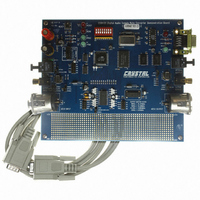CDB8427 Cirrus Logic Inc, CDB8427 Datasheet - Page 3

CDB8427
Manufacturer Part Number
CDB8427
Description
EVALUATION BOARD FOR CS8427
Manufacturer
Cirrus Logic Inc
Datasheet
1.CDB8427.pdf
(14 pages)
Specifications of CDB8427
Main Purpose
Audio, Sample Rate Converter
Embedded
Yes, MCU, 8-Bit
Utilized Ic / Part
CS8427
Primary Attributes
Sample Rate Converter with Digital Audio Transmitter and Receiver
Secondary Attributes
48 kHz Output Sample Rates, AES/EBU, S/PDIF, EIAJ-340, GUI
Product
Audio Modules
Silicon Manufacturer
Cirrus Logic
Silicon Core Number
CS8427
Kit Application Type
Communication & Networking
Application Sub Type
Digital Audio Transceiver
Kit Contents
Evaluation Board
Rohs Compliant
No
Lead Free Status / RoHS Status
Contains lead / RoHS non-compliant
Lead Free Status / RoHS Status
Lead free / RoHS Compliant, Contains lead / RoHS non-compliant
Other names
598-1783
1.
The CDB8427 evaluation board contains a CS8427
and the supporting circuitry necessary for it to op-
erate. The input and output options include AES3
and S/PDIF in optical and coaxial formats. In soft-
ware mode, the control registers of the CS8427 are
set by an Atmel AVR RISC microcontroller. A Mi-
crosoft Windows 98 based program communicates
with the micro through an RS232 port to control the
configuration.
1.1
The features and functions of the CS8427 are de-
scribed in its data sheet.
1.2
The functions of the board are controlled by an At-
mel AVR RISC microcontroller. The board is
equipped with 512 KBytes of static RAM so that
Channel Status and User bits from the AES stream
may be captured and uploaded to the host PC. The
microcontroller communicates with the CS8427
through its SPI port. The Atmel AVR RISC micro-
controller may be bypassed in order to utilize an
external microcontroller through header J10. Head-
er J9 allows the microcontroller on the board to be
programmed with the programmer that is supplied
in the Atmel STK-300 development kit. Additional
software development tools and applications infor-
mation for the Atmel microcontroller are available
at: http://www.atmel.com.
OVERVIEW
CS8427
Microcontroller and Memory
1.3
There are positions for two crystal oscillators on
the board. Both locations are equipped with pin
sockets that allow the oscillators to be removed.
The oscillator labeled U10 provides the 6 MHz
clock for the microcontroller and should not be
changed unless you plan on reprogramming the mi-
cro.
U3 is the oscillator that provides the Output Master
Clock for the CS8427. The board is shipped with a
12.288 MHz crystal oscillator that can be stuffed at
U3 to set the output sampling rate to 48 kHz.
1.4
The RS232 port on the upper right hand side of the
board should be connected to the serial port of the
PC running the CDB8427 control software. Follow
the software instructions to properly configure the
serial port for use with the evaluation board.
1.5
LEDs D8 and D9 on the upper right hand corner of
the board allow the user to determine when data is
being transmitted over the RS232 link. The red
LED D4 is the reset indicator and the red LED D1
is connected to the RERR pin of the CS8427. The
two remaining LEDs on the board are not currently
of use to the end user
Crystal Oscillators
RS232 Port
LED Function Indicators
CDB8427
3



















